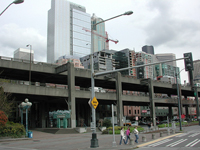The Washington transportation department plans to replace the Alaskan Way Viaduct along Seattle’s waterfront with a deep-bore tunnel underneath downtown Seattle. There is special concern about the project’s fiscal plausibility; the state has estimated that the entire project will cost $4.2 billion. Yet the estimate is preliminary; at this point, Seattle residents have no way of knowing if the actual costs will be lower or higher than the initial estimate.
As a way to inform the debate over Seattle’s deep-bore tunnel, Sightline has prepared a basic comparison of other high-profile tunnels recently constructed in the area: Mt Baker I-90 tunnel expansion, Downtown Seattle Bus tunnel, Sound Transit Beacon Hill tunnel, and King County Brightwater sewage tunnels. The costs of these tunnels tell a cautionary tale.
Cost Overruns For Seattle-Area Tunnel ProjectsKey Findings:
- Cost overruns are commonplace. The downtown Seattle bus tunnel experienced a cost overrun of 56 percent beyond early estimates; Sound Transit’s tunnel underneath Beacon Hill exceeded expected costs by 30 percent; and King County’s bored tunnels for the Brightwater Sewage Plant are over budget.
- Mount Baker Tunnel may be a poor comparison. Although the tunnels are similar in diameters, the geology of Mount Baker was better understood because the original I-90 tunnel had already been constructed through the ridge. Also, the waterfront tunnel could be more than six times as long as the bored portion of the Mount Baker Tunnel.
- Small overruns could be costly. Even small cost overruns on the deep-bore tunnel could be risky for Seattle property owners. A 2.4 percent overrun could cost a Seattle family of four almost $700. A 25 percent cost overrun could saddle Seattle taxpayers with more than $1 billion of new tax liability.







